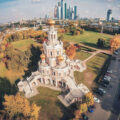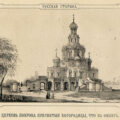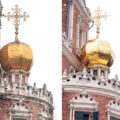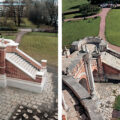The restoration of the facades of the Church of the Intercession of the Blessed Virgin Mary at Fili* has been completed. It took the restorers two years to revitalize the church and make it look almost the same as in the late 17th century.
“The best of the monuments of this style is the Church in Fili, a light lace fairy tale, designed and made with such incomparable perfection…”
Igor Grabar (1871–1960), book “History of Russian Art”, 1910
Heyday and Desolation
The Church of the Intercession at Fili is a five-tier centric temple built in the Naryshkin Baroque style, with three wide open porches richly decorated leading to it. This masterpiece of Russian architecture of the 17th century is a five-storey centric church. The stepped construction of the tiered volumetric composition emphasizes its vertical aspiration to the heavens. One building combines a winter (lower) and summer (upper) church and a bell tower (“church under the bells” — a type of church in which the bell tier is located above the main space). The current building of the church designed as “octagon on cube” Lev Naryshkin, Peter’s I uncle. The best craftsmen, including Karp Zolotarev, who headed the workshop of the “Posolsky Prikaz” (government agency in Russia in 1549–1720, which was in charge of relations with foreign states), took part in the construction and decoration of the interior, and the painting of icons.
During the Patriotic War of 1812, the temple was seriously damaged. Napoleon’s soldiers used it as stables, with the top floor set up for the regimental tailor shop.
In July 1941, the church was closed, the domes removed, and the upper octagon dismantled to prevent German gunners from using the church to aim guns.
Until 1943, the lower temple was used as an infirmary, then, until 1963, as a warehouse for paper products. In 1955, the restoration of the temple began.
In 1971, the church was transferred to the Andrei Rublev Museum, and only in 2000 it became open to parishioners again.
Currently, the iconostasis, many icons, and wall paintings of the temple date back to the 19th century. However, the temple icon The Intercession of the Holy Virgin and the icon of the Three Joys have been preserved since the time of the original structure. Same goes for the oak throne — one of the oldest preserved thrones.
- Повреждения на куполе, кирпичной кладке и декоре. Филигранная работа реставраторов по восстановлению / Damage to the dome, masonry, and decor. Delicate workmanship of the restorers
- Фрагмент открытого гульбища-галереи на арках, к которому с трех сторон ведут широко раскинувшиеся лестницы / Fragment of an open gallery on arches, to which three wide staircases lead
Restoration of the Architectural Monument
The specialists restored the white stone decor and the drainage system — recreated the lost external drainage systems, to not only refurbish the cultural heritage site of federal significance but also to extend its life.
The main restoration work concerned the brickwork. The front external stairs leading to the upper temple were completely rebuilt, the white stone steps and approaches were refurbished and reassembled. The authentic lead waterproofing system of stairs, platforms, and ambulatories was restored.
Special attention was paid to restoring the integrity of the white stone decor and elements of the white stone masonry of the basement, the foundation of arched pillars and columns.
A complex of works has been carried out on the completion of the parapets of the north and west porches as well as the painting of white stone elements and windows.
The decoration of the winter church dates back to the 19th century, the icons and decoration of the summer church date back to the 17th century and a later period and are of museum value.
*Fili is a former suburban village, now a neighborhood in Moscow
Source: Press Service of the Moscow Department of Cultural Heritage
Photo materials courtesy the Church of the Intercession of the Blessed Virgin Mary at Fili




